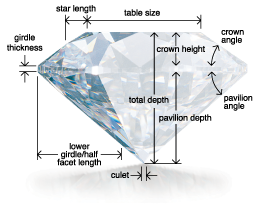GIA's D-to-Z color grading scale is the world's most widely accepted system for describing the color of colorless diamonds. The scale begins with the letter D, representing colorless, and continues, with increasing presence of color, to the letter Z.
Color diamond images are for reference only and may not reflect true diamond color quality grades. Images are not for color diamond grading.
Many of these color distinctions are so subtle that they are invisible to the untrained eye; however, these distinctions make a very big difference in diamond quality and price.
Natural diamonds are the result of carbon exposed to tremendous heat and pressure deep in the earth. This process can result in a variety of internal characteristics called 'inclusions' and external characteristics called 'blemishes.'
Evaluating diamond clarity involves determining the number, size, relief, nature, and position of these characteristics, as well as how these affect the overall appearance of the stone. While no diamond is perfectly pure, the closer it comes, the higher its value.
Clarity diagrams are for reference only and may not reflect true diamond clarity quality grades. Images are not for clarity diamond grading.
Many inclusions and blemishes are too tiny to be seen by anyone other than a trained diamond grader. To the naked eye, a VS1 and an SI2 diamond may look exactly the same, but these diamonds are quite different in terms of overall quality. This is why expert and accurate assessment of clarity is extremely important.
Diamonds are renowned for their ability to transmit light and sparkle so intensely. We often think of a diamond's cut as shape (round, emerald, pear), but a diamond's cut grade is really about how well a diamond's facets interact with light.
The quality of cut is crucial to the diamond's final beauty and value. And of all the 4Cs, it is the most complex and technically difficult to analyze.
The GIA Cut Grading System for the standard round brilliant diamond evaluates seven components. The first three, brightness, fire, and scintillation, consider the diamond's overall face-up appearance. The remaining four, weight ratio, durability, polish, and symmetry, assess a diamond's design and craftsmanship.
The design and craftsmanship of the diamond considers weight ratio (weight of the diamond relative to its diameter), the diamond's girdle thickness (which affects its durability), the symmetry of its facet arrangement, and the quality of polish on those facets.
Diamond carat weight is the measurement of how much a diamond weighs. A metric "carat" is defined as 200 milligrams. Each carat can be subdivided into 100 'points.' This allows very precise measurements to the hundredth decimal place.
All else being equal, diamond price increases with carat weight, because larger diamonds are more rare and more desirable.
But two diamonds of equal carat weight can have very different values (and prices) depending on three other factors of the 4Cs: Clarity, Color, and Cut. It's important to remember that a diamond's value is determined using all of the 4Cs, not just carat weight.
All diamond images and diagrams are for reference only and may not reflect true diamond carat weight.




